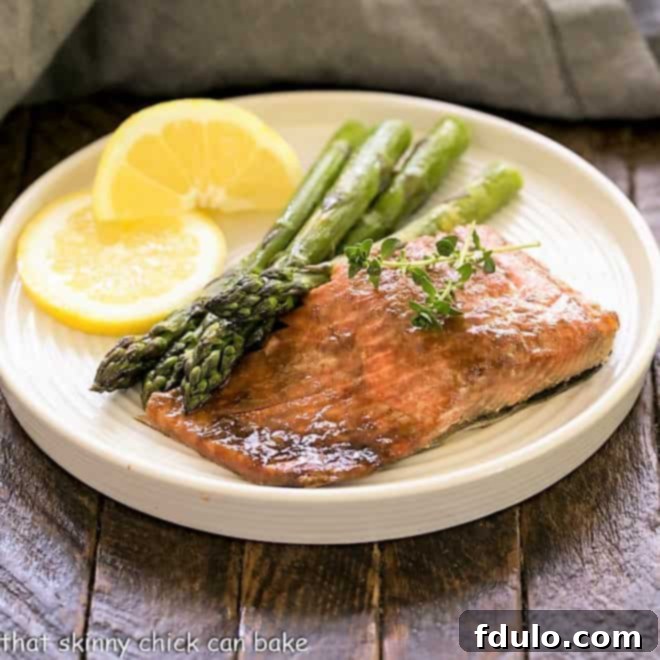Indulge in the culinary delight of these exquisite Easy Glazed Salmon fillets, a dish that epitomizes effortless gourmet cooking. With minimal preparation and a swift cooking time – just 15 minutes in the oven or even quicker on the grill – a spectacular, healthy dinner is effortlessly served. This recipe transforms ordinary weeknights into extraordinary dining experiences, offering a perfect blend of convenience and sophisticated flavor.
What makes this simple Grilled Salmon Recipe truly remarkable is its reliance on readily available kitchen staples. Forget the frantic grocery runs; chances are, you already have most of the ingredients needed to craft this delicious, last-minute, and incredibly healthy entrée. It’s an ideal choice for busy individuals seeking nutritious meals without compromising on taste or quality. Whether you’re a seasoned chef or a novice in the kitchen, this glazed salmon promises a foolproof path to a satisfying and impressive dish.

Why This Glazed Salmon Recipe is a Must-Try
This Easy Glazed Salmon recipe isn’t just another dish; it’s a culinary revelation that consistently impresses with its deceptive simplicity and profound flavor. There are numerous compelling reasons why it deserves a permanent spot in your recipe collection:
- Effortlessly Simple, Yet Exceptionally Flavorful: This is truly one of those recipes that is deceptively easy to prepare, yet yields restaurant-quality results. A few months ago, we served these marinated salmon fillets to dinner guests, and the response was overwhelming. Everyone raved about the taste, and I found myself printing multiple copies of the recipe before they even left! The secret lies in a perfectly balanced marinade that infuses the salmon with rich flavors, making it suitable for both casual family dinners and elegant entertaining.
- Pantry-Friendly Ingredients: You won’t need to hunt for obscure ingredients. With just six core components, most of which are kitchen staples, all I typically need to purchase is the fresh salmon and perhaps a lemon if I’m out. This makes it an incredibly convenient option for impromptu meals or when you’re looking for something quick and satisfying. The ease of ingredient sourcing contributes significantly to the stress-free cooking experience.
- Superior Flavor and Texture Through Versatile Cooking Methods: Whether you choose to grill or bake, this recipe guarantees a delicious outcome. Grilling imparts an irresistible smoky flavor and creates delightfully crispy edges from the high heat, enhancing the overall texture. However, if grilling isn’t an option, a mere 15 minutes in the oven still produces a tender, succulent fillet with a beautifully glazed finish. The harmonious combination of sweet, salty, and citrus notes in the simple marinade and glaze marries perfectly with the rich flavor of salmon, elevating it to an unforgettable dish.
- A Healthy and Nutritious Powerhouse: Salmon is renowned for its incredible health benefits, particularly its high content of Omega-3 fatty acids, which are crucial for heart and brain health. It’s also an excellent source of lean protein, making this glazed salmon an ideal choice for a balanced and nourishing meal. You can enjoy a truly indulgent experience while knowing you’re fueling your body with vital nutrients.
- Quick Preparation for Busy Lifestyles: In today’s fast-paced world, finding time to cook healthy meals can be a challenge. This recipe respects your time, requiring minimal hands-on effort for maximum flavor return. From prep to plate, you’re looking at about 20 minutes, making it the ultimate solution for quick weeknight dinners or when you need a satisfying meal in a pinch.
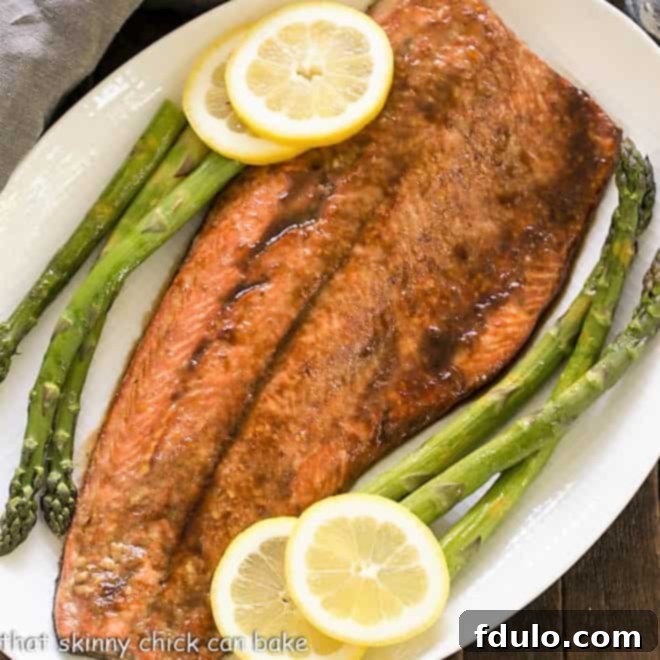
A Beloved Salmon Recipe for Lent and Beyond
This particular seafood entrée made its auspicious debut back in 2011, originally conceived as a delicious option for Lent. It quickly became a family favorite, even if it took some palates a little longer to come around! I fondly recall my youngest, then in high school, opting for a peanut butter sandwich after politely taking a courtesy bite of this marinated salmon. Thankfully, time and taste have worked their magic, and his palate has matured beautifully; he now happily devours all variations of salmon. While I wish I could claim to have weaned my picky husband off his beloved tuna casserole and salmon loaf entirely, I’m delighted that he has expanded his seafood repertoire to enthusiastically include fresh salmon. It’s incredibly rewarding to have such a versatile and simple salmon glaze recipe consistently within one’s culinary toolkit.
Beyond Lent, this recipe is perfect for anyone looking to incorporate more healthy, flavorful seafood into their diet. Salmon is a fantastic source of lean protein and essential Omega-3 fatty acids, making it a smart choice for any meal plan. This recipe also scales beautifully – whether you’re cooking for one, two, or a crowd, it adapts seamlessly. For those empty nesters out there, or couples seeking a perfectly portioned meal, our Marinated Salmon for Two Recipe is another absolute winner, offering the same great flavors in a more intimate serving size. This glazed salmon is a testament to how simple ingredients can create profound satisfaction, turning every meal into a special occasion.
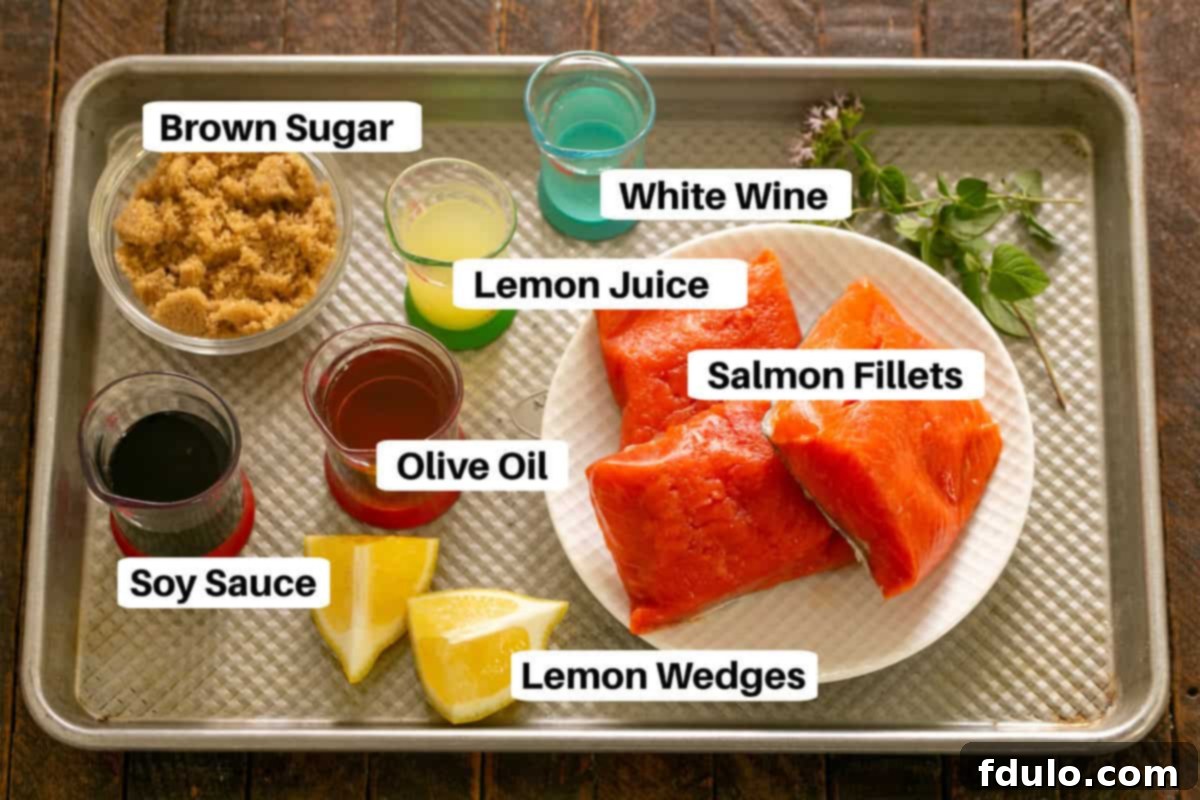
Essential Ingredients for Your Perfect Glaze
The magic of this Easy Glazed Salmon lies in its simple yet powerful marinade, crafted from just a few key ingredients that come together to create a symphony of flavors. Each component plays a crucial role in achieving that irresistible sweet, savory, and tangy profile:
- Brown Sugar: This is the cornerstone of our glaze, imparting a beautiful sweetness that balances the savory elements. More importantly, brown sugar caramelizes wonderfully under heat, whether in the oven or on the grill, creating that coveted sticky, slightly charred exterior that adds incredible depth of flavor and visual appeal to the salmon fillets. It’s essential for that signature glazed finish.
- Olive Oil: Serving as the smooth base for our marinade, olive oil not only adds a lovely richness but also helps to emulsify the other ingredients, ensuring an even coating on the salmon. Its natural fruitiness complements the other flavors without overpowering them, and it plays a vital role in preventing the salmon from sticking to the cooking surface, whether it’s a baking sheet or grill grates.
- Soy Sauce: Beyond its inherent saltiness, soy sauce is indispensable for its profound umami contribution. Umami, often described as the fifth basic taste, refers to a savory, brothy, or meaty flavor that adds incredible depth and complexity. The soy sauce deepens the marinade’s profile, providing a rich, savory backbone that makes the salmon incredibly satisfying and moreish.
- Fresh Lemon Juice: This bright, zesty ingredient is absolutely critical for balancing the richness of the olive oil and the sweetness of the brown sugar, as well as cutting through the umami of the soy sauce. Lemon juice adds a vibrant acidity that brightens the entire dish, preventing it from tasting overly heavy. It also helps to tenderize the fish slightly. A crucial tip: always use fresh lemon juice. The flavor of bottled lemon juice simply cannot compare to the bright, crisp, and natural zest of freshly squeezed lemons, which will make a significant difference in the final taste of your glaze.
- Dry White Wine: Similar to salt, alcohol acts as a powerful flavor enhancer, bringing out the best in all the other ingredients. A dry white wine, such as Sauvignon Blanc or Pinot Grigio, adds a subtle complexity and aromatic depth to the marinade. Don’t worry about the alcohol content; almost all of it will evaporate and cook off during the boiling of the glaze and again during the baking or grilling process, leaving behind only its wonderful flavor contributions. For those who prefer to avoid alcohol, a good quality chicken broth or even apple cider vinegar (in smaller amounts) can be used as a substitute, though the flavor profile will differ slightly.
Step-by-Step: Crafting Your Perfect Glazed Salmon
Preparing this Easy Glazed Salmon is a straightforward process that yields incredibly rewarding results. Follow these simple steps to create a delicious and healthy meal that’s sure to impress.
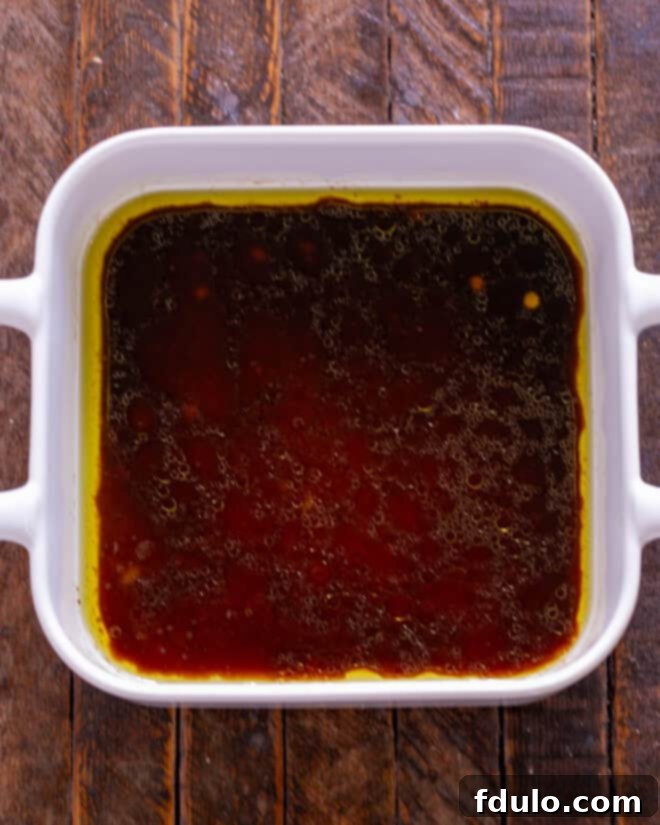




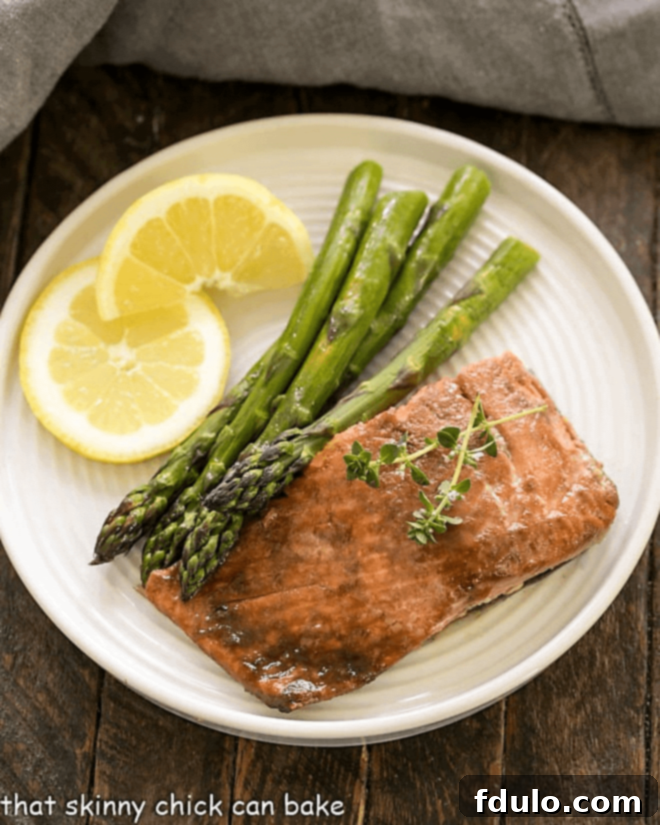
Expert Tips for Perfectly Glazed Salmon Every Time
Achieving perfectly cooked, juicy, and flavorful glazed salmon is incredibly easy with a few expert tips. These insights will help you master the process, whether you’re grilling or baking:
- Understanding Doneness: The 10-Minute Rule and Beyond: A common rule of thumb for cooking fish is 10 minutes per inch of thickness. However, this is a general guideline, and actual cooking times can vary significantly based on your cooking method and equipment. For instance, if my husband is grilling on our Big Green Egg at temperatures exceeding 500ºF, the salmon will cook much faster than in my oven set to 400ºF. Always monitor your fish closely.
- Achieving Your Preferred Doneness: While I prefer my tuna very rare with just the sides seared, for salmon, I find medium-rare to medium to be ideal. Medium-rare salmon will be opaque on the outside with a slightly translucent, pinkish center, whereas medium will be opaque throughout. The photo provided in this article showcases salmon cooked to a medium doneness, with no translucency remaining.
- PRO-Tip: Use a Meat Thermometer for Accuracy: The best way to ensure your salmon is cooked to perfection is by using an instant-read meat thermometer. For medium-rare wild salmon, aim for an internal temperature of 120ºF. For farmed salmon, which has a higher fat content, 125ºF is ideal for medium-rare. After removing the salmon from the heat, cover it loosely with foil and allow it to rest for 5-10 minutes. This crucial resting period allows the internal temperature to rise another 5-10ºF and helps the juices redistribute, resulting in a moister, more tender fillet.
- Wild vs. Farmed Salmon: Understanding the Differences: Both wild and farmed salmon offer excellent protein and Omega-3 fatty acids, but they have distinct characteristics. Farmed salmon typically contains more fat, which makes it more forgiving if slightly overcooked, as it’s less likely to dry out. It also often has a more buttery texture due to this higher fat content. I personally prefer wild salmon for its leaner texture and robust, distinct flavor, though it tends to be more expensive. Choose according to your preference and budget, as both will be delicious with this glaze.
- Optimizing Marinade Time: While seafood is often recommended for shorter marinating times, salmon is a heartier fish that can withstand a bit longer. The marinade for this recipe is relatively simple, but you can enhance flavor absorption by marinating the salmon for up to 45 minutes, especially if you’re baking it in the oven. For quick grills, 10-20 minutes is sufficient.
- Keep the Skin On: It’s always best to leave the skin on your salmon fillets while cooking. The skin acts as a protective layer, helping to keep the delicate flesh intact and preventing it from drying out. Plus, when cooked properly (especially on the grill or in a hot pan), the skin can become wonderfully crispy and delicious.
- Grilling for Superior Flavor: My absolute preference for this recipe is grilling over oven-baking. The smoky notes imparted by the grill elevate this fish to an even more incredible culinary experience. If grilling isn’t an option, and you’re baking in the oven, consider giving the salmon a minute or two under the broiler towards the end of the cooking time. This will help create that beautiful, caramelized, browned top layer, mimicking some of the char from grilling.
- Basting for Extra Flavor and Glaze: Don’t forget to baste your salmon a few times during the roasting or grilling process using the easy salmon glaze. This is especially important when oven-roasting, as it helps build layers of flavor and contributes to that desirable sticky, glossy finish.
- PRO-Tip: Always Cook Leftover Marinade for Basting: This is a crucial food safety step. Any marinade that has come into contact with raw fish must be cooked before it can be safely used as a glaze for basting or serving. After removing the salmon, pour any remaining marinade into a small saucepan and bring it to a rolling boil for at least 1-2 minutes. This ensures that any raw juices are thoroughly cooked, making it safe to drizzle over your finished salmon for an extra burst of flavor.
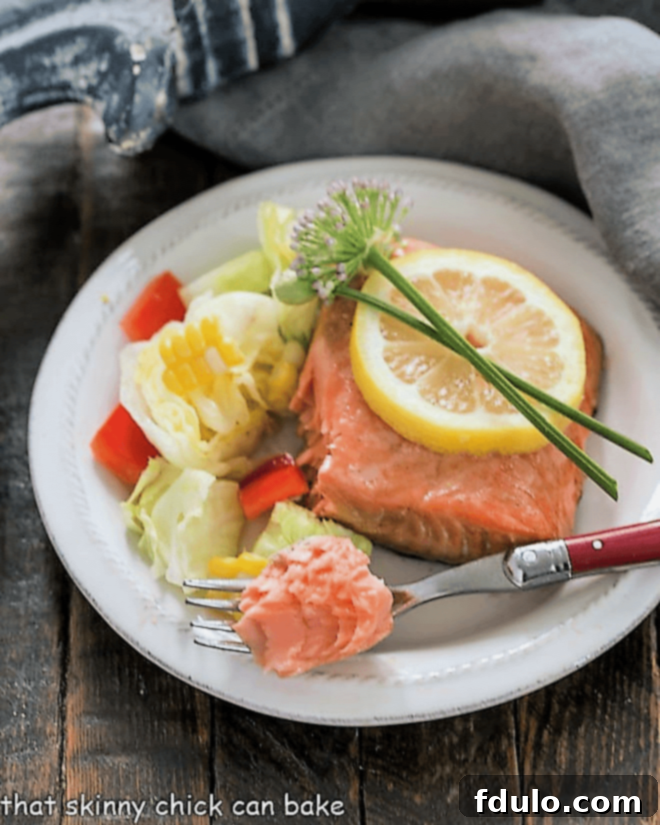
Frequently Asked Questions About Glazed Salmon
Absolutely, frozen salmon works perfectly in this recipe! In fact, it’s a common misconception that fresh salmon in the US is always “fresh-never-frozen.” Most salmon sold in the US is flash-frozen at sea shortly after being caught, then thawed for distribution to retailers, which actually helps preserve its quality and freshness. To use frozen salmon, simply defrost it in the refrigerator overnight. Once thawed, you can proceed with the recipe as usual, ensuring it marinates for about 6 hours to allow the flavors to fully penetrate the fish. This extended marinating time is beneficial for thawed salmon.
The most reliable way to determine if your salmon is perfectly cooked is by using an instant-read meat thermometer. The USDA recommends cooking fish to an internal temperature of 145°F for food safety. However, many chefs and home cooks prefer a slightly lower temperature for a more tender, succulent fillet. For instance, I often aim for medium doneness, which is typically between 120-125°F. At this temperature, medium-done salmon will have a pinkish center, will appear opaque throughout, and will feel slightly firm to the touch when gently pressed. Visually, the flesh should flake easily with a fork. Avoid overcooking, as this can lead to dry, tough salmon.
Glazed salmon is incredibly versatile and pairs beautifully with a wide array of side dishes. The sweet and savory notes of the glaze complement both starchy and green vegetables wonderfully. Consider serving it with a flavorful Italian rice pilaf with toasted almonds for a hearty complement, or a crisp green salad, perhaps an arugula salad with a light vinaigrette, to add freshness. Roasted or sautéed vegetables are always an excellent choice; try roasted asparagus with balsamic browned butter, lemon garlic broccoli, or sautéed green beans with grape tomatoes. During warmer months, grilled corn on the cob with basil butter is a fantastic seasonal pairing. For a lighter touch, a simple quinoa salad or steamed new potatoes would also be delightful.
To store leftover glazed salmon, allow it to cool completely, then transfer it to an airtight container and refrigerate promptly. It will stay fresh for up to 2-3 days. When reheating, it’s best to do so gently to prevent drying it out. Place the salmon on a baking sheet, cover it loosely with foil, and reheat in a preheated oven at 275-300°F (135-150°C) for about 10-15 minutes, or until just warmed through. You can also gently warm it in a skillet over low heat with a lid. Avoid microwaving if possible, as it can make the salmon rubbery and dry.
This Easy Glazed Salmon recipe is naturally dairy-free! To make it gluten-free, simply substitute regular soy sauce with tamari, which is a gluten-free soy sauce alternative. All other ingredients are typically gluten-free. Always double-check ingredient labels to ensure no hidden gluten or dairy components, especially in sauces or condiments.
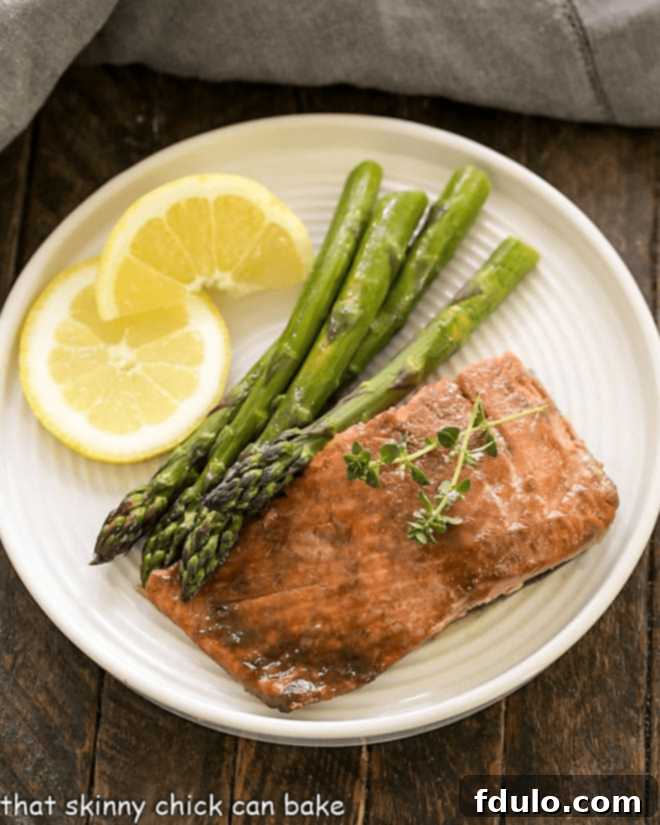
Explore More Delicious Seafood Recipes
If, like us, you appreciate the tradition of a meatless meal on Fridays during Lent, or simply wish to incorporate more healthy and delicious seafood into your weekly menu, you’ll find plenty of inspiration among these exceptional recipes. From light and fresh preparations to rich and flavorful dishes, there’s something here to satisfy every seafood lover:
- Dijon Lemon Caper Salmon from Amanda’s Cookin’ – A zesty and briny salmon dish with a sophisticated flavor profile.
- Air Fryer Cedar Plank Salmon from Life Currents Blog – Experience the smoky aroma and tender texture of cedar plank salmon, made easy in an air fryer.
- Potato Shingled Salmon – A truly unique and visually stunning presentation with a flavorful pesto, this dish even won over my sometimes-picky husband!
- Maple Mustard Glazed Salmon – A delightful blend of sweet maple and tangy mustard creates a vibrant glaze for this salmon.
- Glazed Salmon with Fruit Salsa – A refreshing and vibrant twist, pairing tender salmon with a bright, sweet, and tangy fruit salsa.
- Grilled Shrimp Scampi – We absolutely adore the nuanced, smoky flavors that come through when shrimp is grilled over charcoal! So incredibly good.
- Sea Bass with Tomatoes, Olives and Capers – This Mediterranean-inspired topping is simply fabulous with the mild, flaky white fish of sea bass.
- Discover even more Delicious Seafood Recipes for endless culinary inspiration.
Stay in touch through social media @ Instagram, Facebook, and Pinterest. Don’t forget to tag me when you try one of my recipes! And if you love the results, please give it a 5-star rating in the recipe card below.

Easy Glazed Salmon
5 minutes
15 minutes
20 minutes
4 servings
An easy, delicious salmon recipe made with kitchen staples.
Ingredients
- 4 salmon fillets (8 ounces each)
- ¼ cup brown sugar
- ¼ cup olive oil
- 3 tablespoons soy sauce
- 2 tablespoons fresh lemon juice
- 2 tablespoons dry white wine
- Lemon wedges
Instructions
- Preheat the oven to 400ºF (200°C) if you plan to roast your salmon instead of grilling. Prepare your baking dish by lightly greasing it or lining it with parchment paper for easy cleanup.
- In a medium bowl, combine the brown sugar, olive oil, soy sauce, fresh lemon juice, and dry white wine. Whisk thoroughly until the brown sugar is completely dissolved and all ingredients are well combined. This forms your flavorful marinade and glaze.
- Place the salmon fillets in a shallow baking dish or a resealable bag. Pour the prepared glaze generously over the salmon, ensuring each fillet is well-coated. Allow the salmon to marinate for 10-20 minutes at room temperature, turning at least once to ensure even flavor absorption. For deeper flavor, you can marinate for up to 45 minutes in the refrigerator, especially if using thawed frozen salmon.
- While the salmon is marinating, pour any leftover marinade from the dish (before the salmon is placed on the cooking surface) into a small saucepan. Bring it to a rolling boil over medium-high heat. Let it boil for 1-2 minutes, then reduce heat and simmer for another minute. This crucial step ensures any raw juices are cooked off, making the glaze safe to use for basting and serving. Set aside.
- Cook the salmon using your chosen method:
- Grilling: Preheat your grill to medium-high heat. Lightly oil the grates to prevent sticking. Place salmon fillets skin-side down on the grill. Grill for 4-7 minutes per side, basting with the cooked glaze every few minutes, until cooked to your desired doneness.
- Baking: Place marinated salmon fillets (skin-side down if applicable) on your prepared baking sheet. Bake in the preheated 400ºF (200°C) oven for approximately 12-18 minutes, depending on thickness, basting every few minutes with the cooked glaze. For a browned, caramelized top, broil for the last 1-2 minutes, watching carefully to prevent burning.
Cook until the internal temperature reaches your preferred doneness (120-125°F for medium-rare, 145°F for well-done as per USDA).
- Once cooked, transfer the salmon to a serving platter. Allow it to rest for 5 minutes, covered loosely with foil, to allow juices to redistribute. Serve hot, garnished with fresh lemon wedges, and an extra drizzle of the safely cooked glaze if desired.
Notes
Adapted from Everyday Food
Nutrition Information:
Yield:
4
Serving Size:
1
Amount Per Serving:
Calories: 650Total Fat: 42gSaturated Fat: 7gTrans Fat: 0gUnsaturated Fat: 31gCholesterol: 143mgSodium: 800mgCarbohydrates: 14gFiber: 1gSugar: 12gProtein: 51g
HOW MUCH DID YOU LOVE THIS RECIPE?
Please leave a comment on the blog or share a photo on Pinterest
